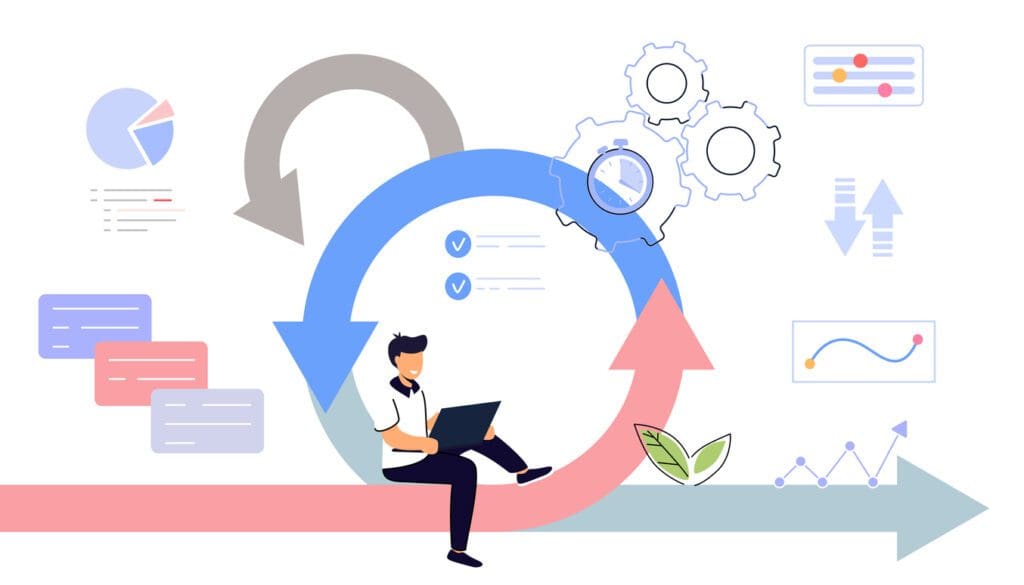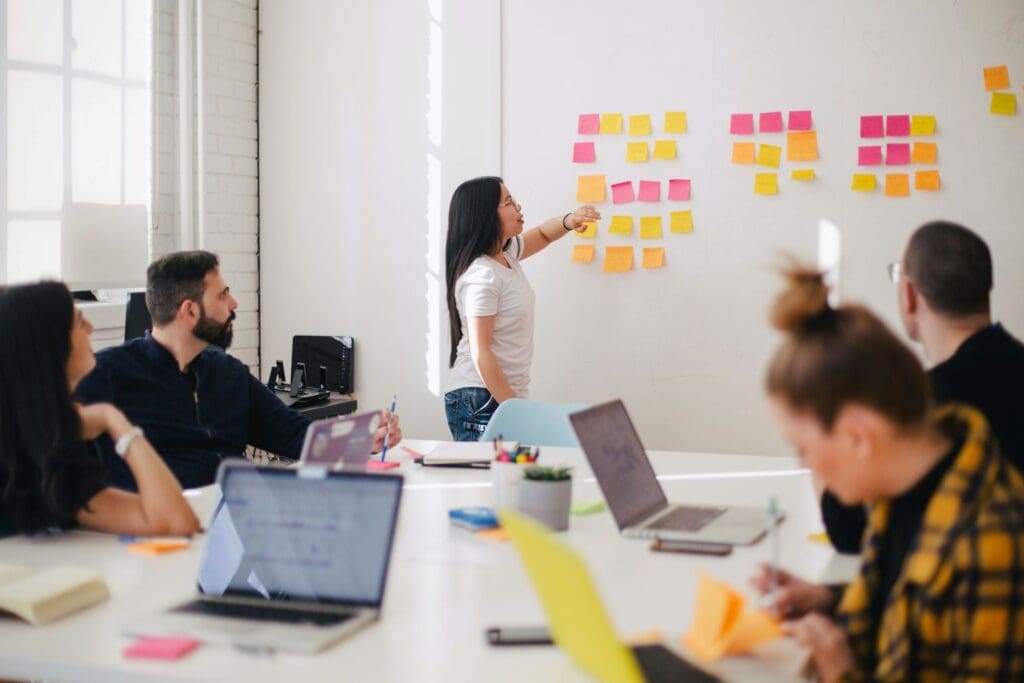Table of Contents
Agile Methodology: How It Works, Benefits, and Examples
Are you looking for a better way to manage your software development projects? Do you want to improve collaboration and communication among team members, deliver high-quality products faster, and adapt to changing customer needs and market conditions? If so, you may be interested in agile methodology.
This blog will explore the basics of agile methodology, including its principles, frameworks, and benefits. We’ll examine agile methodology’s key roles and responsibilities, including the product owner, the cross-functional team, and the scrum master. We’ll also look at the tools and techniques that support agile methodology, from project management software to communication and collaboration tools.
Whether you’re new to agile methodology or looking to improve your existing agile practices, this blog will provide you with actionable insights and best practices for successful agile project management and software development. So, buckle up and get ready to learn all about agile methodology!
What is Agile Methdology?
Agile methodology is a project management and software development approach that emphasises flexibility, adaptability, and customer satisfaction. It is based on a set of principles and frameworks that enable teams to work more collaboratively and iteratively, delivering working software increments in shorter timeframes.
Benefits of Agile Methodology
Flexibility and Adaptability
One of the key benefits of agile methodology is that it enables teams to respond quickly to changes in requirements or customer needs. By delivering working software frequently, teams can gather feedback and adjust their approach to ensure that they are meeting the customer’s needs.
Customer Satisfaction
Agile methodology emphasises collaboration and communication with the customer, which can lead to better outcomes and improved customer satisfaction. By delivering working software frequently and adapting to changes in requirements or customer needs, teams can ensure that the product is delivering value to the customer.
Collaborative Teamwork
The agile methodology emphasises cross-functional teams and collaboration, which can lead to better.
Agile Frameworks: Scrum, Kanban
There are several frameworks for implementing Agile methodology in software development projects. Scrum, Extreme Programming (XP) and Kanban are popular frameworks.


Scrum is an Agile framework that emphasises teamwork, iterative development cycles, and the delivery of high-quality software. The Scrum framework includes three roles: the Product Owner, the Scrum Master, and the Development Team. The Product Owner prioritises the backlog and ensures that the team delivers value to the customer. The Scrum Master facilitates the Scrum process and ensures the team follows the Scrum framework. The Development Team is responsible for delivering the product increment.
Kanban is an Agile framework that emphasises the visualisation of the workflow and the continuous delivery of software. The Kanban framework includes three core principles: visualise the workflow, limit work in progress, and manage the flow. Kanban emphasises the importance of continuous improvement and encourages the team to adapt to changes in the project.
Extreme Programming (XP) is an Agile framework that emphasises teamwork, rapid feedback, continuous testing, and continuous delivery. XP includes practices such as Test-Driven Development (TDD), Pair Programming, Continuous Integration, and Continuous Deployment. XP encourages the team to prioritise customer satisfaction and to deliver working software frequently.
Principles of Agile Methodology
The Agile Manifesto outlines four key values and twelve principles that are the foundation of Agile methodology.
The four key values of Agile methodology are:
- Individuals and interactions over processes and tools
- Working software over comprehensive documentation
- Customer collaboration over contract negotiation
- Responding to change by following a plan
The twelve principles of Agile methodology are:
- Satisfy the customer through early and continuous delivery of valuable software.
- Welcome changing requirements, even late in the development process.
- Deliver working software frequently, with a preference for shorter timescales.
- Collaborate with customers and stakeholders throughout the project.
- Build projects around motivated individuals, and give them the support and trust they need to get the job done.
- Use face-to-face communication whenever possible.
- Working software is the primary measure of progress.
- Maintain a sustainable pace of work for the team.
- Focus on technical excellence and good design.
- Keep things simple.
- Encourage self-organising teams.
- Regularly reflect on the team’s performance and make adjustments as necessary.
How Agile Methodology Works?
Agile methodology is a project management and software development approach that emphasises flexibility, collaboration, and continuous improvement. Unlike traditional project management approaches like the waterfall method, which relies on detailed planning and strict timelines, agile methodology is more iterative and adaptable.
Cross-functional Teams
The agile methodology encourages forming cross-functional teams that include individuals with different skills and backgrounds. Cross-functional teams can work together to identify problems, find solutions quickly, and help ensure the project delivers the desired value to the customer.
Product Owner Role
The Product Owner is a key role in Agile methodology, prioritises the backlog, and ensures that the team delivers value to the customer. The Product Owner works closely with the Development Team to ensure that the product meets the customer’s needs and is responsible for making decisions about what features to include in the product and when they should be delivered.
Iterative Development Cycles
The agile methodology emphasises iterative development cycles, with each iteration focused on delivering a small functionality that provides value to the customer. The team receives feedback from the customer after each iteration, which helps to guide the development process and ensure that the product meets the customer’s needs.
Continuous Improvement
Agile methodology encourages continuous improvement in the development process and the final product. The team is encouraged to reflect on their performance after each iteration and to make adjustments as necessary. This process helps to ensure that the project is always moving in the right direction and that the final product meets the needs of the customer.
Benefits of using Agile and OKR together
Agile and OKR (Objectives and Key Results) are two methodologies organisations use to improve performance and achieve strategic objectives. Agile is an iterative approach to project management that emphasises flexibility and collaboration, while OKR is a framework for setting and achieving goals that emphasise alignment and accountability. They can help organisations adapt to change, stay focused on their goals, and continuously improve performance.
Using Agile with OKR can bring several benefits, such as:
Increased flexibility and adaptability: Agile allows teams to respond quickly to changes and adjust their plans accordingly, while OKR ensures that everyone is working towards the same strategic objectives.
Improved alignment and focus: OKR provides a clear framework for setting and prioritising goals, while Agile helps teams stay focused on delivering value and achieving those goals.
Enhanced collaboration and communication: Agile encourages frequent collaboration and communication, while OKR promotes transparency and accountability, leading to better teamwork and more effective decision-making.
Continuous improvement: Agile and OKR emphasise continuous learning and improvement, leading to a culture of innovation and experimentation.
Combining Agile with OKR can help organisations achieve better performance, faster delivery, and greater business agility.
Examples of Agile Methodology in Practice
Spotify
Spotify, the music streaming platform, is a well-known example of agile methodology in practice. Spotify has implemented a scaled agile framework, allowing the company to maintain agility and flexibility as it grows. This framework consists of a hierarchy of agile teams that work in parallel and communicate regularly. Each team has its own product owner, who is responsible for prioritising the backlog and ensuring the team is working on the most important items.


One of the key features of Spotify’s agile methodology is its focus on cross-functional teams. These teams consist of developers, designers, and other professionals who work together to deliver high-quality products. By bringing together individuals with diverse skills and expertise, Spotify is able to ensure that its products meet the needs of its customers and the market.
Toyota
One of the key principles of Toyota’s agile methodology is the “genchi genbutsu” approach, which involves going to the source to see and understand the situation. This approach is based on the idea that you cannot truly understand a problem unless you experience it firsthand. By going to the source, Toyota can identify problems and inefficiencies quickly and make improvements in real time.
Conclusion
Agile methodology is often considered better than traditional methods for several reasons. Its focus on flexibility, collaboration, and continuous improvement allows teams to deliver high-quality products that meet the needs of their customers and the market.
Whether you are a small startup or a large corporation, there are many benefits to adopting agile methodology in your development processes. By embracing cross-functional teams, iterative development cycles, and continuous improvement, you can stay ahead of the competition and deliver products that your customers will love.
As the world of software development and project management continues to evolve, we will likely see even more emphasis placed on agile methodology in the future. By staying up-to-date with the latest approaches to agile project management, you can ensure that your team is well-equipped to tackle any challenge that comes their way.



